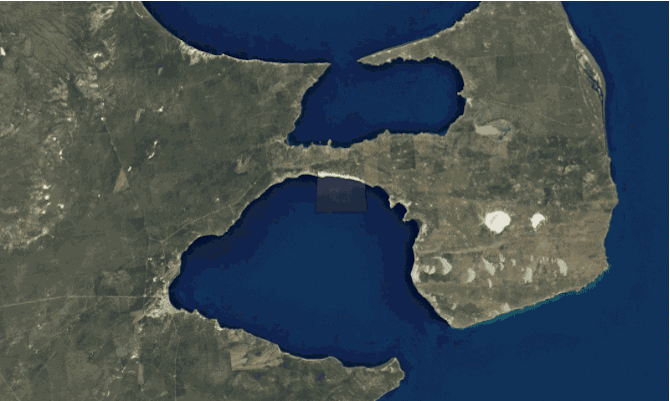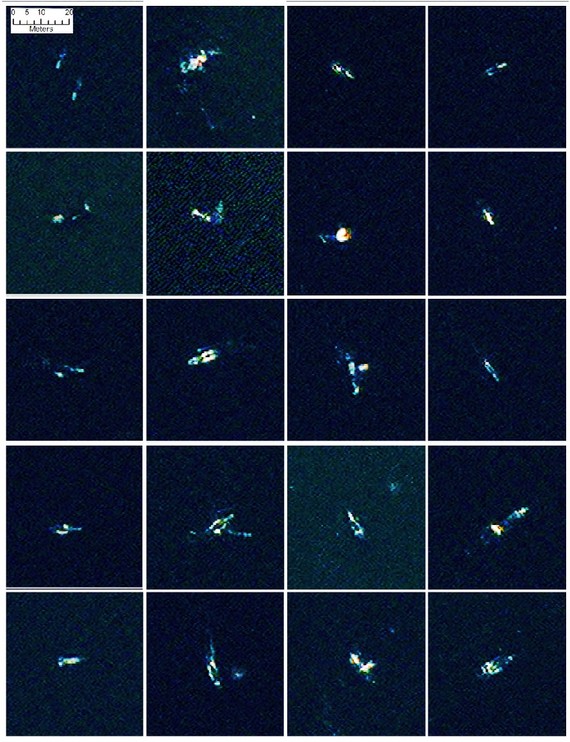When satellite companies talk about the imagery they capture, they play up how you can see big, human-made things: planes and trains and parking lots. Sometimes they might mention, too, how important sky pictures are to foresters or farmers.
But as I’ve seen more and more projects that involve imagery, I’ve been struck by the non-human things you can see. Specifically, the animals.
At least two projects have glimpsed individual creatures at “commercially available” resolutions, about the same level as you can see on Google Maps. Here are the two kinds of animals you can see from space:
1. Elephants
Above is an elephant walking by itself in the Botswana’s Okavango Delta. You can even see its very elephantine shadow—there’s the trunk!
Mostly, though, elephants are spotted in herds. Here are some in Addo Elephant National Park in South Africa:

These images came out of a project run by two organizations that often focus on military or humanitarian projects: DigitalGlobe, the dominant American provider of satellite imagery, and the Enough Project, an anti-genocide non-profit.
This project, though, focused on reducing elephant poaching.
Analysts examined images of Garamba National Park in the Democratic Republic of Congo, one of the oldest such parks in Africa. They searched for roads and stream beds that poachers might use to sneak into the protected territory, then they matched that with data from elephant-attached radio trackers to figure out how poachers were entering the park—and thus where park rangers should patrol.
In other words, the analysis searched for “choke points”—places where park rangers could focus their attention to keep poachers out of the park, said Heath Rasco, a senior geospatial analyst at DigitalGlobe.
The analysis, in other words, didn’t depend on (or really involve) finding pictures of elephants. But they did find them, like these ones in Botswana:

Rasco said that sometimes he was less sure that the big mammals in the image were elephants. The image below, he said, was clearly a herd of large grazers—although just which kind of grazing animal, he couldn’t say for sure.

2. Whales
A year before the elephant project, a different team was using DigitalGlobe imagery to look for other animals: whales.
Southern right whales breed every year in the shallow waters off the coast of the Peninsula Valdés in Argentina. Right whales are very large, and scientists at the British Antarctic Survey guessed that they might be able to be identified while “at or near the surface.”
They were, well, right. Look at the water beneath the Valdés from July to November (breeding and calf-rearing season), and you can see whales.
Or just one whale, as below:

Unlike with elephants, where seeing the animals themselves is more of a curiosity, being able to identify whales from space has real use. Though very important, it’s hard to monitor whale populations. Write the researchers:
‘How many are there?’ is a question that is often difficult to address in ecology particularly for marine species that are generally inaccessible and cryptic. This is clearly demonstrated in whales where, despite their enormous size, robust population estimates are very difficult to obtain.
The British Antarctic Survey’s method permits the work to be done by algorithm, because whales have a recognizable data footprint in image files.
Here are some more of what the researchers identified as “probable whales”:

Though they may just look like white blurs, some decidedly cetaceous features can be seen. The tail, for instance, is visible in many of them. And they look even more whale-like when compared to aerial imagery (in the top right corner):

Researchers have tried identifying a whale from space before. In 2002, a different set of scientists trained a satellite’s eye on SeaWorld, trying to see if they could catch an orca in the tanks where they knew an orca to be. They couldn’t—mostly because satellites, at that time, were still too low-resolution.
But now they can. It makes you wonder what else will be possible, in 2028, to see from the sky.
This article was originally published at http://www.theatlantic.com/technology/archive/2015/03/the-animals-you-can-see-from-space/388502/
